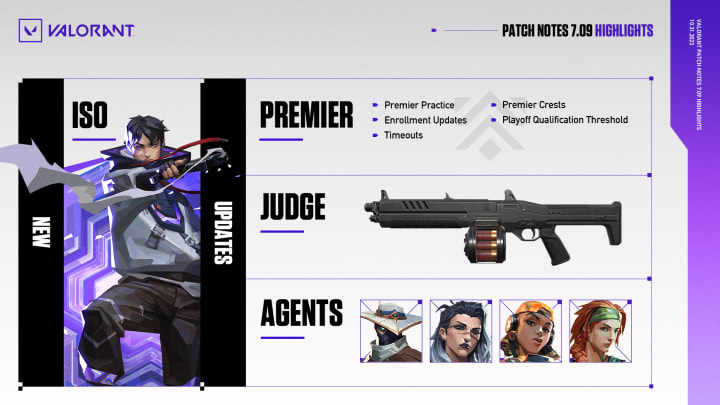The Unseen Hand: How Game Balance Updates Forge the Future of Competitive Gaming
In the vibrant, ever-shifting world of online competitive video games, few events stir the pot quite like a major balance patch. For millions of players invested in titles like Valorant, League of Legends, or Apex Legends, the release of patch notes is a momentous occasion, met with a mixture of excitement, trepidation, and fervent debate. These updates are far more than simple bug fixes; they are the digital equivalent of a tectonic shift, capable of redefining strategies, dethroning dominant characters, and elevating forgotten ones to stardom. This process is the lifeblood of any live-service game, a delicate and complex craft that blends hard data, player psychology, and forward-thinking game design. Understanding the anatomy of these patches reveals the intricate technical and philosophical challenges that developers face. It’s a continuous, high-stakes dialogue between the creators and the gaming community, where a single percentage point change can have a ripple effect that touches everything from casual weekend matches to the grand stages of professional esports.
Section 1: The Philosophy of the Patch: Why Developers Intervene
At its core, game balancing is a deliberate act of intervention. Developers don’t change their games on a whim; every buff, nerf, and rework is a calculated move aimed at achieving specific, long-term goals for the health of the game. This philosophy is built on a foundation of data analysis, community sentiment, and a deep understanding of the game’s core mechanics.
The Data-Driven Approach vs. Player Perception
Modern game development, especially in the realm of PC gaming and console gaming, is heavily reliant on telemetry. Developers have access to a staggering amount of data: agent/character pick rates across different skill levels, win percentages, kill/death/assist ratios, and even the frequency of ability usage in specific scenarios. This quantitative data provides an objective look at what’s happening in the game. For instance, if a character in a MOBA has a 95% pick/ban rate in competitive gaming, it’s a clear statistical indicator that they are too powerful. However, data doesn’t tell the whole story. The gaming community’s perception—the “feel” of playing against a certain character—is equally important. An agent in an FPS game might have a balanced 50% win rate, but if the community finds their abilities “unfun” or “frustrating” to play against, developers may still intervene. This balancing act between objective metrics and subjective player experience is one of the greatest challenges in game design.
Combating Stagnation and Defining the Meta
The term “meta” (metagame) refers to the dominant strategies, characters, and team compositions that are considered most effective at any given time. While a stable meta can provide a consistent competitive environment, a stagnant one leads to boredom and predictability. If the same five heroes or agents are seen in every match of Overwatch News or Valorant News, the game loses its dynamic appeal. Balance patches are the primary tool for intentionally disrupting the meta. By nerfing overpowered elements and buffing underutilized ones, developers encourage experimentation and force players to discover new strategies. This constant evolution is crucial for long-term player engagement and is a major topic of discussion in esports news and on game streaming platforms like Twitch.
The Inevitable “Nerf Hammer” and Power Creep
In live-service games, developers regularly introduce new content—characters, weapons, or abilities—to keep the experience fresh. This can lead to a phenomenon known as “power creep,” where new additions are progressively more powerful than older ones to make them appealing, slowly raising the overall power level of the game. To counteract this, nerfs (reductions in power) are essential. While often met with outcry from players who have mastered the nerfed element, these adjustments are necessary to prevent the game from spiraling into an unbalanced state. A brutal nerf to a popular character can feel punishing, but it often serves the greater good of strategic diversity and game health.

Section 2: The Technical Toolkit: How Balance Changes Are Made
Implementing balance changes is a precise, technical process that involves manipulating the core code and game variables. Developers, often using powerful platforms like Unreal Engine or Unity, have a wide array of levers they can pull to fine-tune the gameplay experience, ranging from subtle tweaks to complete overhauls.
The Numbers Game: Adjusting Core Variables
The most common form of balancing involves changing numerical values. These are the fundamental building blocks of a character’s or weapon’s effectiveness.
- Damage and Health: The simplest change is altering how much damage an ability or weapon does, or changing a character’s total health or shields. In a battle royale like Fortnite or Call of Duty: Warzone, a 5% damage reduction on a popular assault rifle can completely change the long-range meta.
- Cooldowns and Timers: Increasing or decreasing the cooldown time of an ability directly impacts its availability and strategic value. Reducing the cooldown of a defensive ability by just two seconds can make a character significantly more survivable.
- Resource Costs: In many games, powerful “ultimate” abilities require a resource to be built up. Adjusting the number of points or amount of energy needed is a direct way to control the frequency of game-changing moments.
- Weapon Mechanics: For FPS games, developers can tweak variables like recoil patterns, spread, fire rate, and reload speed. A slight increase in a weapon’s vertical recoil can be the difference between a laser-accurate rifle and one that requires significant skill to control.
Case Study: A Hypothetical Agent Buff
Imagine an agent in a tactical shooter whose primary ability is a smoke grenade that obscures vision. Data shows this agent has the lowest pick rate in competitive play. The developers decide to buff them. They could:
- Reduce the cooldown: Allowing the agent to use smokes more frequently for executing or retaking sites.
- Increase the duration: Making the smokes last longer, providing a more reliable window for a team to make a move.
- Increase the size: A larger smoke could block off more angles, making it a more powerful tool for map control.
Reworks: From Minor Tweaks to Full Redesigns
Sometimes, a character’s core kit is fundamentally flawed or outdated. In these cases, simple number changes aren’t enough. A “rework” involves redesigning one or more of a character’s abilities from the ground up. This is a far more resource-intensive process, requiring new art, animation, sound design, and extensive programming. Reworks are often reserved for older characters in long-running games like Dota 2 or League of Legends whose original designs no longer fit within the modern gaming landscape. This is a major undertaking in game development that can completely revitalize a character’s role in the game.
Section 3: The Ripple Effect: Widespread Impact of Balance Changes
A single balance patch doesn’t exist in a vacuum. Its effects ripple outwards, influencing every level of the game’s ecosystem, from the highest tiers of professional play to the content created by the gaming community.
Shifting Tides in Esports and Competitive Gaming

In the world of esports, teams spend thousands of hours perfecting strategies built around the current meta. A significant patch can render those strategies obsolete overnight. For example, a nerf to a key agent might force a team’s star player, known for their mastery of that agent, to adapt or switch roles. Conversely, a buff to an obscure character could lead to the rise of a new “pocket pick” that gives a team a unique strategic advantage. This forces professional organizations to be incredibly adaptable, constantly theorycrafting and practicing to stay ahead of the curve. Major tournaments following a patch are often the most exciting, as they become a showcase for innovation and new strategic thinking.
The Casual and Ranked Player Experience
For the vast majority of the player base, balance changes directly impact the day-to-day experience. A buff to a mechanically demanding character might make them more accessible and fun for lower-ranked players. A nerf to a “pub-stomp” character—one that is overly effective in less coordinated, public matches—can reduce frustration across the board. These changes can alter the flow of a typical match, influence which characters are most popular, and ultimately shape the collective experience of the gaming community. This is a hot topic in PlayStation News and Xbox News as console players adapt to the same changes as their PC gaming counterparts.
The Creator Economy and Gaming Culture
The impact of balance patches extends beyond the game itself. The content creator ecosystem on platforms like Twitch and YouTube thrives on newness. When a patch drops, it fuels a wave of new content. Streamers and YouTubers race to create guides on “How to Play the New Reworked Hero,” “Top 5 Meta Picks in Patch 11.08,” or “Is [Nerfed Character] Still Viable?” This not only provides valuable information to players but also drives engagement and viewership. The meta shift becomes a central topic of conversation, shaping the discourse within the gaming culture for weeks or even months.
Section 4: Navigating the New Meta: Recommendations for Players

For players, a new patch can be disorienting. What worked yesterday might not work today. However, with the right mindset and approach, adapting to a new meta can be one of the most rewarding aspects of playing a competitive game.
Best Practices for Adaptation
- Read the Patch Notes Thoroughly: Don’t just skim for your main character. Understand the full scope of the changes, including systemic adjustments to the economy, maps, or core mechanics. Knowledge is your first and best advantage.
- Experiment in Low-Stakes Environments: Before jumping into a ranked match, spend time in casual modes, deathmatch, or a practice range. Get a feel for the new ability timings, weapon recoil, or character movements.
- Be Open-Minded: Your main character may have been nerfed into a less viable position. Instead of getting frustrated, view this as an opportunity to learn a new character or role. Expanding your hero/agent pool makes you a more flexible and valuable teammate.
- Watch and Learn: Pay attention to how professional players and high-level streamers are adapting. They often discover new techniques and strategies quickly. Analyzing their gameplay can significantly shorten your own learning curve.
Common Pitfalls to Avoid
One of the biggest mistakes players make is having a knee-jerk reaction. A character being “nerfed” doesn’t always mean they are “unplayable.” Often, it means they are now more situational or require a higher skill level to be effective. Avoid writing off a character or strategy immediately. Give the meta time to settle, as the community’s initial perception is often different from where things land after a few weeks of experimentation and optimization. The evolution of strategy is what makes games with deep mechanics, from RPG games to strategy games, so compelling.
Conclusion: The Continuous Cycle of Evolution
Game balancing is a dynamic and unending process that sits at the very heart of modern gaming tech and live-service game design. It is a complex dance between statistical analysis, developer intuition, and community feedback. Each patch, with its carefully considered buffs and brutal nerfs, is a chapter in the game’s ongoing story. These updates do more than just change numbers; they challenge players, foster innovation, and ensure that the competitive landscapes of our favorite video games remain fertile ground for new strategies and memorable moments. For the dedicated player, learning to adapt to these shifts is not a chore but a core part of the skill set, proving that in the world of competitive gaming, the only true constant is change.












